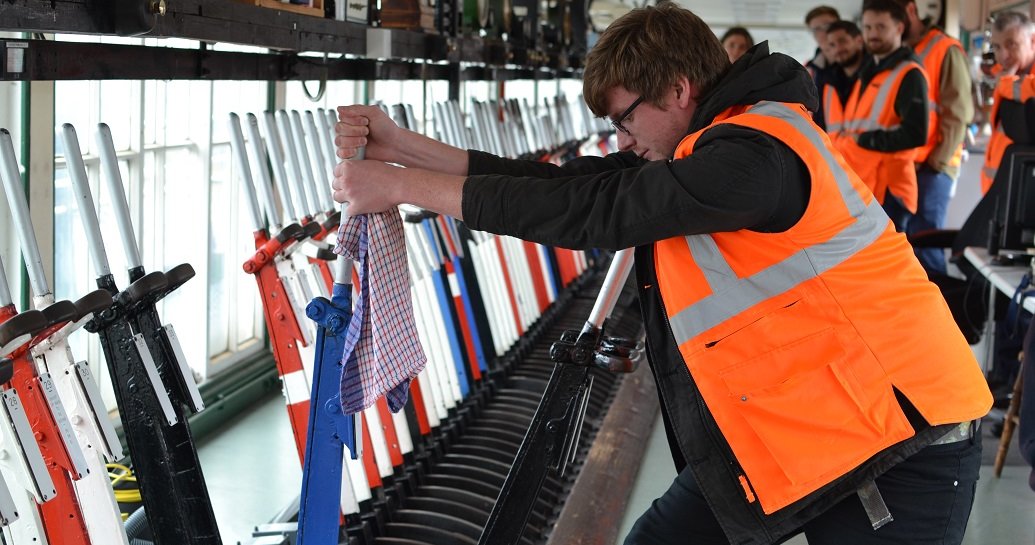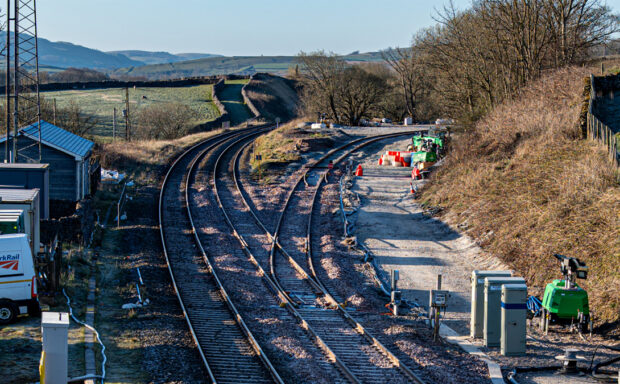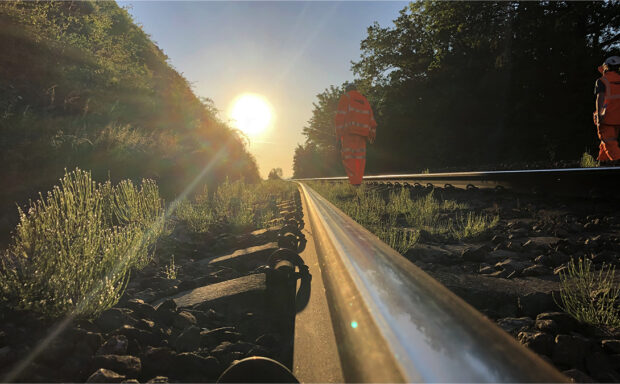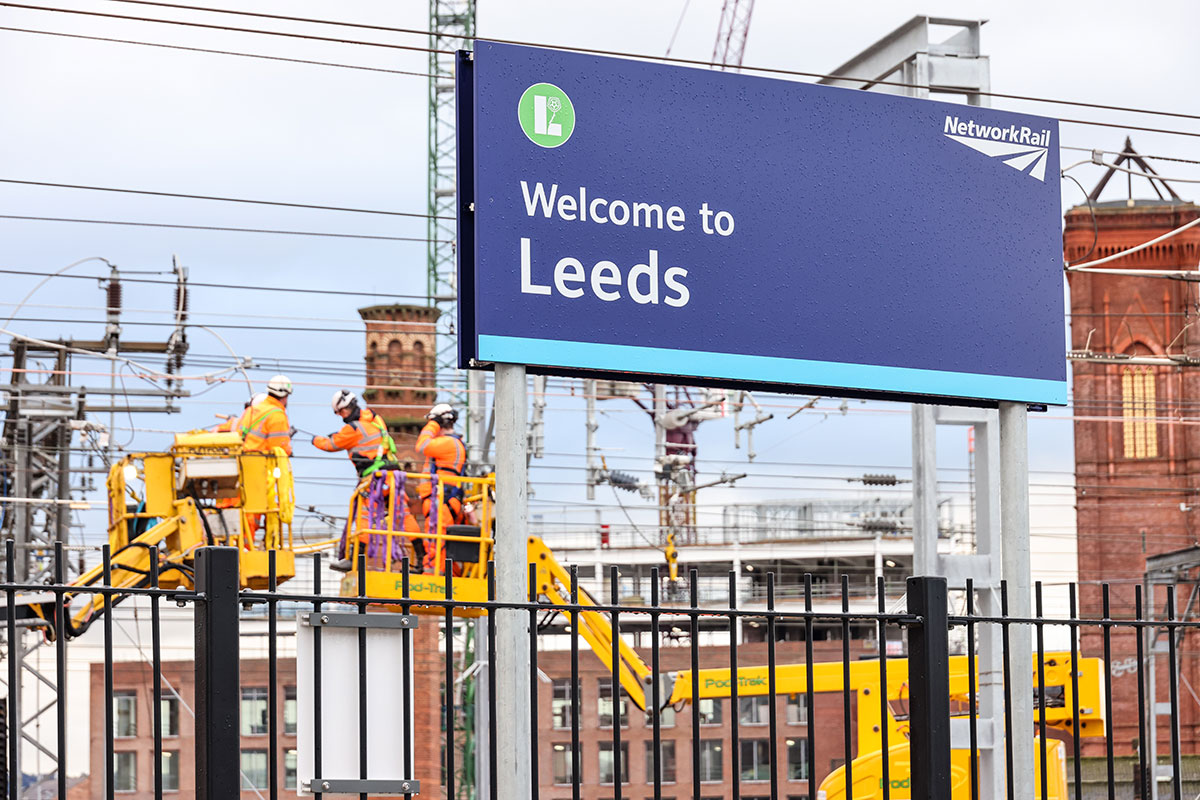“We’re doing one of the last steam-age jobs on the network.”
At Shrewsbury railway station, signaller Jamie Green is steeping young Network Rail graduates in history.
He works at Severn Bridge Junction – the largest working mechanical signal box in the world. The grade II-listed building houses 180 levers, all dating from 1903. The box doesn’t just embody a rare tradition, it continues to perform a vital function on a modern railway.
Severn Bridge Junction, which opened in 1904, will remain open for the foreseeable future, although Network Rail is updating signalling across Britain to provider better, more reliable and more frequent services. The introduction of new rail traffic management technology will lead to much greater capacity for passengers and freight operators.
However, signallers like Jamie remain crucial to Shrewsbury, ensuring all trains pass safely through the station without state-of-the-art technology.
Click on the gallery to see Severn Bridge Junction, signallers Jamie Green and Kevin Collins, and signallers in 1962
Three storeys high, Jamie and his colleagues are a world away from much of the network. The team has computer systems and paper sheets as back-up but typically works from memory, pulling levers in a specific sequence according to the platform a train should arrive at.
Jamie says: “It’s very satisfying the way it connects together. It’s like a mechanical jigsaw puzzle.”
Origins
Two railway operating companies – the London & North Western Railway and the Great Western Railway – worked together to build five lines converging at Shrewsbury despite rivalry between them. They competed to connect South Wales’s coal and materials supplies with the industrialised regions of the Midlands and North West, and to transport passengers between Liverpool and London.
Click on the gallery to see a plan of Severn Bridge Junction, the exterior and the view from the signal box with Shrewsbury Castle on the left
Today Shrewsbury station, which opened in 1848, is less busy than the likes of Derby but it was historically known as a hub of significant commercial activity. In fact, an article written by JT Lawrence for Railway Magazine in 1905 described the station as a “switch board”, with claims that more traffic was “interchanged and redistributed at Shrewsbury than even at York”.
It said: “Whilst the chief importance of Shrewsbury Station lies in its various connections, it must not be supposed that local conditions are unimportant. The town is the centre of one of the chief agricultural districts in England and Wales.”
On its name, Lawrence added: “There does not seem, at first sight, to be much connection between Shrewsbury Railway Station and the Severn Tunnel. In fact, to the casual observer, the only point of common interest would appear to be that the one goes under the river whilst the other stands on top of it. But, nevertheless, it is to the Severn Tunnel that Shrewsbury owes the position it claims as one of the most important distributing centres in the country – if not the most.”
Click on the gallery to see more images
Network Rail is proud of its heritage, which dates from the 19th century. It works with railway heritage organisations to document the history, operation and way of life associated with signal boxes, many of which are listed.
On a Monday in October, groups of Network Rail graduates are visiting Severn Bridge Junction, eager to learn more about traditional railway operations.
Under close supervision from Jamie and fellow signaller Kevin Collins, they take turns operating the heavy signals themselves – a rare opportunity made unique by a distinct difference in the design of the London & North Western Railway’s levers. Those at Shrewsbury are unusual, each featuring a catch at the front of the lever rather than behind the handle.
The signaller’s cloth, not strictly necessary at Shrewsbury, protects levers at other signal boxes from losing their polish. Jamie says: “We’re keeping the tradition alive.”
Mid-tour, Jamie wows the young employees by moving points – pieces of track interlocked with signals that allow trains to change tracks – with the Edwardian equipment.
In 1905, Lawrence praised the station’s signalling system, noting its guard rails. They run along the track in areas with restricted clearance, such as bridges and tunnels, to keep trains’ wheels aligned in case they come off the line.
He said: “The lines approaching the station are laid out in curves of somewhat short radius, and the system of guard rails is deserving of notice. Instead of being in short lengths, as is frequently the case, they are in apparent continuity with the respective facing points, and any derailment seems to be impossible.”
They remain in place today, specifically because of the tight curvature around the station.
Network Rail graduates from the Western and Wales routes
Invaluable experience
Oliver Easton is among the graduate engineers, based on the Western and Wales routes, on today’s trip. He organised the visit himself to enable his younger colleagues to experience an operational signalling environment and contrast it with modern rail operating centres (ROC).
He said: “Having chosen the signalling discipline and having experienced life at Network Rail for over a year, this was my first visit to a mechanical signal box. It is a very useful thing for new graduate engineers to see so that they can learn about mechanical signalling, and especially aids electrical graduates when they come to making the choice between the signalling and telecoms or electrification and plant disciplines. I hope the visit inspired some of the new engineers to pick the signalling and telecoms discipline.”
Severn Bridge Junction bears no resemblance to the modern rail operating centres across Britain today. After climbing the dark, narrow stairs, visitors are rewarded with rare panoramic views – Shrewsbury Castle to the south and, in clear weather, the Shropshire hills on the horizon, says Jamie: “Here, a sunny day isn’t wasted.”
Click on the gallery to see inside Severn Bridge Junction and engineers examining the system
Preserving railway history: five things saved by Network Rail




